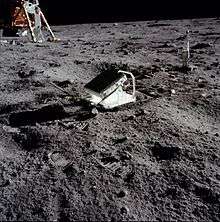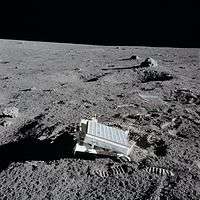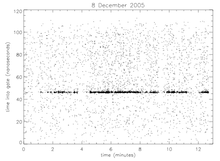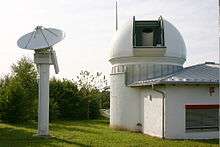Lunar Laser Ranging experiment
The ongoing Lunar Laser Ranging experiment or Apollo landing mirror measures the distance between surfaces of Earth and the Moon using laser ranging. Lasers at observatories on Earth are aimed at retroreflectors planted on the Moon during the Apollo program (11, 14, and 15), and the two Lunokhod missions.[1] Laser light pulses are transmitted and reflected back to Earth, and the round-trip duration is measured. The lunar distance is calculated from this value.

Overview


The first successful tests were carried out in 1962 when a team from the Massachusetts Institute of Technology succeeded in observing laser pulses reflected from the Moon's surface using a laser with a millisecond pulse length.[2] Similar measurements were obtained later the same year by a Soviet team at the Crimean Astrophysical Observatory using a Q-switched ruby laser.[3] Greater accuracy was achieved following the installation of a retroreflector array on July 21, 1969, by the crew of Apollo 11, and two more retroreflector arrays left by the Apollo 14 and Apollo 15 missions have also contributed to the experiment. Successful lunar laser range measurements to the retroreflectors were first reported by the 3.1 m telescope at Lick Observatory, Air Force Cambridge Research Laboratories Lunar Ranging Observatory in Arizona, the Pic du Midi Observatory in France, the Tokyo Astronomical Observatory, and McDonald Observatory in Texas.
The uncrewed Soviet Lunokhod 1 and Lunokhod 2 rovers carried smaller arrays. Reflected signals were initially received from Lunokhod 1, but no return signals were detected after 1971 until a team from University of California rediscovered the array in April 2010 using images from NASA's Lunar Reconnaissance Orbiter.[4] Lunokhod 2's array continues to return signals to Earth.[5] The Lunokhod arrays suffer from decreased performance in direct sunlight—a factor considered in reflector placement during the Apollo missions.[6]
The Apollo 15 array is three times the size of the arrays left by the two earlier Apollo missions. Its size made it the target of three-quarters of the sample measurements taken in the first 25 years of the experiment. Improvements in technology since then have resulted in greater use of the smaller arrays, by sites such as the Côte d'Azur Observatory in Nice, France; and the Apache Point Observatory Lunar Laser-ranging Operation (APOLLO) at the Apache Point Observatory in New Mexico.
Principle
The distance to the Moon is calculated approximately using the equation: distance = (speed of light × duration of delay due to reflection) / 2
To compute the lunar distance precisely, many factors must be considered in addition to the round-trip time of about 2.5 seconds. These factors include the location of the Moon in the sky, the relative motion of Earth and the Moon, Earth's rotation, lunar libration, polar motion, weather, speed of light in various parts of air, propagation delay through Earth's atmosphere, the location of the observing station and its motion due to crustal motion and tides, and relativistic effects.[7] The distance continually changes for a number of reasons, but averages 385,000.6 km (239,228.3 mi) between the center of the Earth and the center of the Moon.[8]
At the Moon's surface, the beam is about 6.5 kilometers (4.0 mi) wide[9][lower-roman 1] and scientists liken the task of aiming the beam to using a rifle to hit a moving dime 3 kilometers (1.9 mi) away. The reflected light is too weak to see with the human eye. Out of 1017 photons aimed at the reflector, only one is received back on Earth, even under good conditions. They can be identified as originating from the laser because the laser is highly monochromatic. This is one of the most precise distance measurements ever made, and is equivalent in accuracy to determining the distance between Los Angeles and New York to within 0.25 mm (0.01 in).[6][10]
The upcoming MoonLIGHT reflector, that may be placed during an attempt by the private MX-1E lander, is designed to increase measurement accuracy 100 times over existing systems.[11][12][13] MX-1E was set for launch in July 2020,[14] however, as of February 2020, the launch of the MX-1E has been canceled.[15]
Results
Lunar laser ranging measurement data is available from the Paris Observatory Lunar Analysis Center,[16] and the active stations. Some of the findings of this long-term experiment are:
- The Moon is spiraling away from Earth at a rate of 3.8 cm/year.[9] This rate has been described as anomalously high.[17]
- The Moon probably has a liquid core of about 20% of the Moon's radius.[5] The radius of the lunar core-mantle boundary is determined as 381±12 km.[18]
- The universal force of gravity is very stable. The experiments have constrained the change in Newton's gravitational constant G to a factor of (2±7)×10−13 per year.[19]
- The likelihood of any Nordtvedt effect (a hypothetical differential acceleration of the Moon and Earth towards the Sun caused by their different degrees of compactness) has been ruled out to high precision,[20][21][22] strongly violating the strong equivalence principle.
- Einstein's theory of gravity (the general theory of relativity) predicts the Moon's orbit to within the accuracy of the laser ranging measurements.[5]
- Gauge freedom plays a major role in a correct physical interpretation of the relativistic effects in the Earth-Moon system observed with LLR technique.[23]
- The distance to the Moon can be measured with millimeter precision.[24]
- The polar flattening of the lunar core-mantle boundary is determined as (2.2±0.6)×10−4.[18]
- The free core nutation of the Moon is determined as 367±100 yr.[18]
Photo gallery
 Apollo 14 Lunar Ranging Retro Reflector (LRRR)
Apollo 14 Lunar Ranging Retro Reflector (LRRR) APOLLO Collaboration photon pulse return times
APOLLO Collaboration photon pulse return times
 Laser Ranging at Goddard Space Flight Center
Laser Ranging at Goddard Space Flight Center
See also
- Apache Point Observatory Lunar Laser-ranging Operation
- Apollo Lunar Surface Experiments Package
- Tom Murphy (physicist) (principal investigator of Apollo's reflector experiment)
- Carroll Alley (previous principal investigator of Apollo's reflector experiment)
- Earth–Moon–Earth communication
- Lidar
- Lunar distance (astronomy)
- Lunokhod programme
- Satellite laser ranging
- Space geodesy
- Third-party evidence for Apollo Moon landings
- List of retroreflectors on the Moon
- List of artificial objects on the Moon
References
- During the round-trip time, an Earth observer will have moved by around 1 km (depending on their latitude). This has been presented, incorrectly, as a 'disproof' of the ranging experiment, the claim being that the beam to such a small reflector cannot hit such a moving target. However the size of the beam is far larger than any movement, especially for the returned beam.
- Chapront, J.; Chapront-Touzé, M.; Francou, G. (1999). "Determination of the lunar orbital and rotational parameters and of the ecliptic reference system orientation from LLR measurements and IERS data". Astronomy and Astrophysics. 343: 624–633. Bibcode:1999A&A...343..624C.
- Smullin, Louis D.; Fiocco, Giorgio (1962). "Optical Echoes from the Moon". Nature. 194 (4835): 1267. Bibcode:1962Natur.194.1267S. doi:10.1038/1941267a0.
- Bender, P. L.; et al. (1973). "The Lunar Laser Ranging Experiment: Accurate ranges have given a large improvement in the lunar orbit and new selenophysical information" (PDF). Science. 182 (4109): 229–238. Bibcode:1973Sci...182..229B. doi:10.1126/science.182.4109.229. PMID 17749298.
- McDonald, K. (26 April 2010). "UC San Diego Physicists Locate Long Lost Soviet Reflector on Moon". University of California, San Diego. Retrieved 27 April 2010.
- Williams, James G.; Dickey, Jean O. (2002). Lunar Geophysics, Geodesy, and Dynamics (PDF). 13th International Workshop on Laser Ranging. 7–11 October 2002. Washington, D. C.
- "It's Not Just The Astronauts That Are Getting Older". Universe Today. 10 March 2010. Retrieved 24 August 2012.
- Seeber, Günter (2003). Satellite Geodesy (2nd ed.). de Gruyter. p. 439. ISBN 978-3-11-017549-3. OCLC 52258226.
- Murphy, T. W. (2013). "Lunar laser ranging: the millimeter challenge" (PDF). Reports on Progress in Physics. 76 (7): 2. arXiv:1309.6294. Bibcode:2013RPPh...76g6901M. doi:10.1088/0034-4885/76/7/076901. PMID 23764926.
- Espenek, F. (August 1994). "NASA - Accuracy of Eclipse Predictions". NASA/GSFC. Retrieved 4 May 2008.
- "Apollo 11 Experiment Still Going Strong after 35 Years". NASA/JPL. 20 July 2004. Retrieved 4 May 2008.
- Currie, Douglas; Dell'Agnello, Simone; Delle Monache, Giovanni (April–May 2011). "A Lunar Laser Ranging Retroreflector Array for the 21st Century". Acta Astronautica. 68 (7–8): 667–680. Bibcode:2011AcAau..68..667C. doi:10.1016/j.actaastro.2010.09.001.
- Tune, Lee (10 June 2015). "UMD, Italy & MoonEx Join to Put New Laser-Reflecting Arrays on Moon". UMD Right Now. University of Maryland.
- Boyle, Alan (12 July 2017). "Moon Express unveils its roadmap for giant leaps to the lunar surface ... and back again". GeekWire. Retrieved 15 March 2018.
- Moon Express Lunar Scout (MX-1E), RocketLaunch.Live, retrieved 27 July 2019
- "MX-1E 1, 2, 3". Retrieved 24 May 2020.
- "Lunar Laser Ranging Observations from 1969 to May 2013". SYRTE Paris Observatory. Retrieved 3 June 2014.
- Bills, B. G.; Ray, R. D. (1999). "Lunar Orbital Evolution: A Synthesis of Recent Results". Geophysical Research Letters. 26 (19): 3045–3048. Bibcode:1999GeoRL..26.3045B. doi:10.1029/1999GL008348.
- Viswanathan, V.; Rambaux, N.; Fienga, A.; Laskar, J.; Gastineau, M. (9 July 2019). "Observational Constraint on the Radius and Oblateness of the Lunar Core‐Mantle Boundary". Geophysical Research Letters. 46 (13): 7295–7303. arXiv:1903.07205. doi:10.1029/2019GL082677.
- Müller, J.; Biskupek, L. (2007). "Variations of the gravitational constant from lunar laser ranging data". Classical and Quantum Gravity. 24 (17): 4533. doi:10.1088/0264-9381/24/17/017.
- Adelberger, E. G.; Heckel, B. R.; Smith, G.; Su, Y.; Swanson, H. E. (1990). "Eötvös experiments, lunar ranging and the strong equivalence principle". Nature. 347 (6290): 261–263. Bibcode:1990Natur.347..261A. doi:10.1038/347261a0.
- Williams, J. G.; Newhall, X. X.; Dickey, J. O. (1996). "Relativity parameters determined from lunar laser ranging". Physical Review D. 53 (12): 6730–6739. Bibcode:1996PhRvD..53.6730W. doi:10.1103/PhysRevD.53.6730. PMID 10019959.
- Viswanathan, V; Fienga, A; Minazzoli, O; Bernus, L; Laskar, J; Gastineau, M (May 2018). "The new lunar ephemeris INPOP17a and its application to fundamental physics". Monthly Notices of the Royal Astronomical Society. 476 (2): 1877–1888. arXiv:1710.09167. doi:10.1093/mnras/sty096.
- Kopeikin, S.; Xie, Y. (2010). "Celestial reference frames and the gauge freedom in the post-Newtonian mechanics of the Earth–Moon system". Celestial Mechanics and Dynamical Astronomy. 108 (3): 245–263. Bibcode:2010CeMDA.108..245K. doi:10.1007/s10569-010-9303-5.
- Battat, J. B. R.; Murphy, T. W.; Adelberger, E. G.; et al. (January 2009). "The Apache Point Observatory Lunar Laser-ranging Operation (APOLLO): Two Years of Millimeter-Precision Measurements of the Earth-Moon Range1". Publications of the Astronomical Society of the Pacific. 121 (875): 29–40. Bibcode:2009PASP..121...29B. doi:10.1086/596748. JSTOR 10.1086/596748.
External links
- "Theory and Model for the New Generation of the Lunar Laser Ranging Data" by Sergei Kopeikin
- Apollo 15 Experiments - Laser Ranging Retroreflector by the Lunar and Planetary Institute
- "History of Laser Ranging and MLRS" by the University of Texas at Austin, Center for Space Research
- "Lunar Retroreflectors" by Tom Murphy
- Station de Télémétrie Laser-Lune in Grasse, France
- Lunar Laser Ranging from International Laser Ranging Service
- "UW researcher plans project to pin down moon's distance from Earth" by Vince Stricherz, UW Today, 14 January 2002
- "What Neil & Buzz Left on the Moon" by Science@NASA, 20 July 2004
- "Apollo 11 Experiment Still Returning Results" by Robin Lloyd, CNN, 21 July 1999

